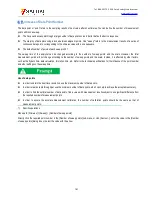
Tel: 886.2.2175 2930 Email: [email protected]
www.salukitec.com
169
=26.4dB
=18.5dB
Therefore, one of the following methods can be applied to obtain accurate results in reflection measurement of the low-loss 2-port
device.
Connect one high-quality load to the output end of the tested device after one-port calibration.
Insert one 10dB attenuator between the output of the tested device and the analyzer after one-port calibration.
Directly connect the output of the tested device to the analyzer after 2-port measurement calibration.
6.3.
Increase of Dynamic Range
The dynamic range refers to the difference between the maximum power allowed to be input into the analyzer and the minimum power
(base noise) which can be tested. To make the measurement correct and effective, the input signal must be within the dynamic range.
In order to greatly change the signal amplitude of measurement, such as the filter passband and stop-band, it is important to increase
the dynamic range. Fig. 6.3 is a typical dynamic range of measurement.
Fig. 6.3 Dynamic Range
In order to reduce the instability of measurement, the dynamic range of the analyzer should be larger than the response of the tested
device. For example, the accuracy can be improved if the response of the tested device is at least 10dB more than the base noise.
The following methods can help to increase the dynamic range.
Dynamic range and measurement time
As some analyzers have the characteristics of alternating sweep, the dynamic range can be increased so as to increase the
measurement time.
6.3.1.
Increase of Input Power of Device
1) The input power of the tested device can be increased so that the output power of the tested device can be accurately tested and
measured by the network analyzer.
2) If the input of the receiver is too high, compression distortion may be caused. If the input reaches to a certain degree, the
receiver may be damaged.
If the input level r15dBm, the receiver may be damaged.
















































